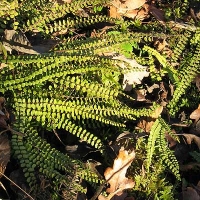 Asplenium trichomanes L.
Asplenium trichomanes L.
 Maidenhair Spleenwort
Maidenhair Spleenwort
 Fausse capillaire
Fausse capillaire
 Brauner Streifenfarn
Brauner Streifenfarn
 Brongstillege Sträifefar
Brongstillege Sträifefar
Class: Pteridopsida
Family: Aspleniaceae
Status
* – not threatened

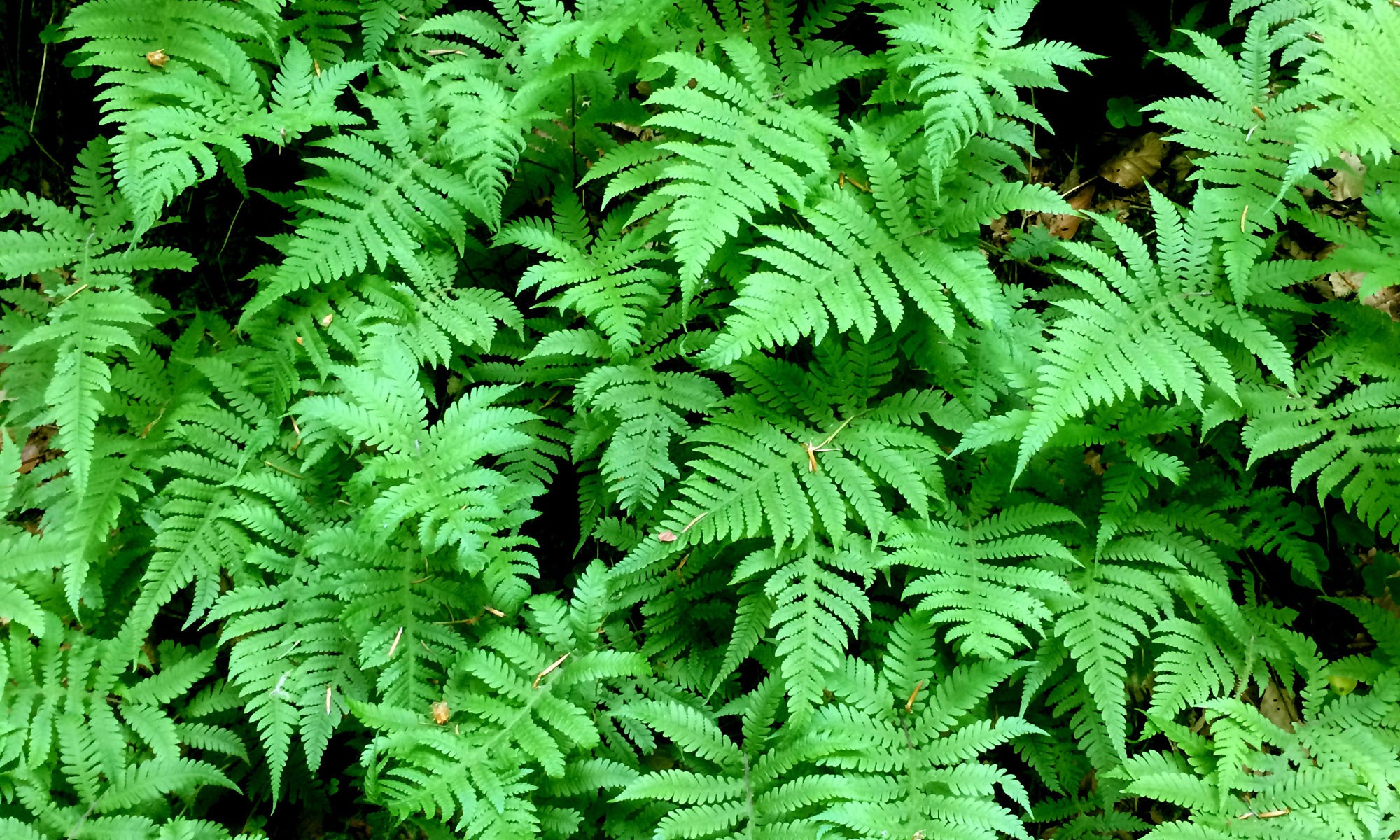
Online Atlas of the Pteridophytes of Luxembourg
 Asplenium scolopendrium L.
Asplenium scolopendrium L.
 Hart’s tongue
Hart’s tongue
 Scolopendre, langue de cerf
Scolopendre, langue de cerf
 Hirschzungenfarn, Hirschzunge
Hirschzungenfarn, Hirschzunge
 Hirschzong-Sträifefar, Hirschzong
Hirschzong-Sträifefar, Hirschzong
Class: Pteridopsida
Family: Aspleniaceae
LRlc – lower risk least concern
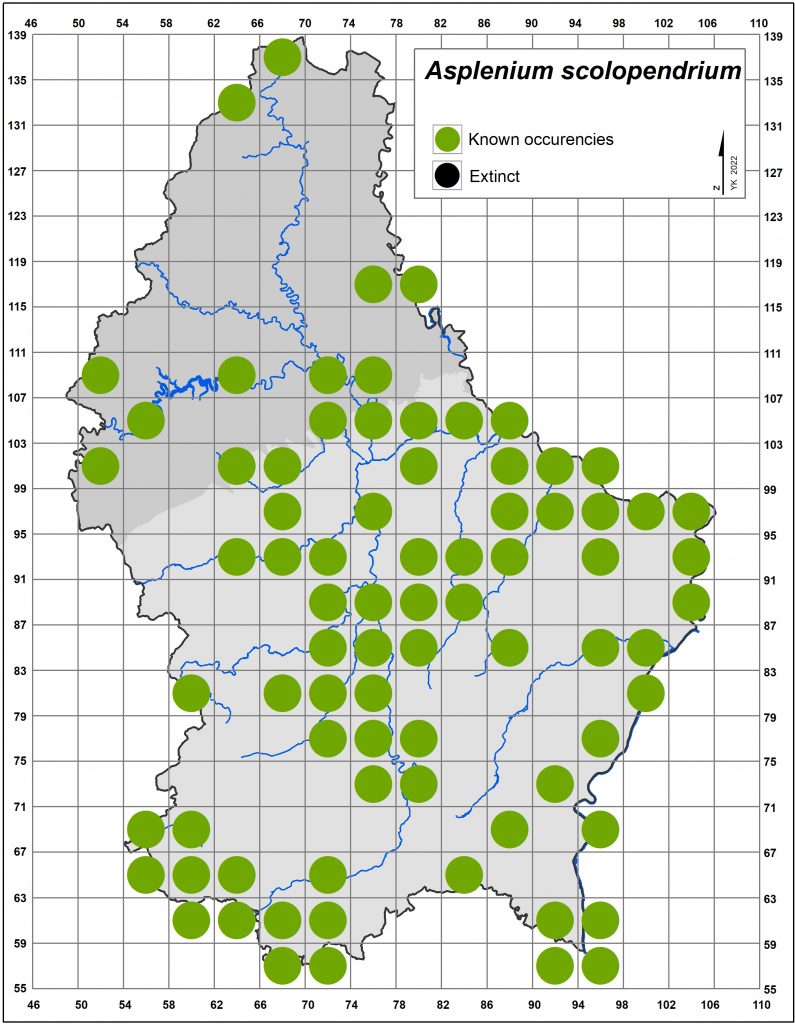
Krippel, Y., 2021. Asplenium scolopendrium ‘Furcatum’ et autres formes curieuses au Grand-Duché de Luxembourg. Dumortiera 118: 31-34.
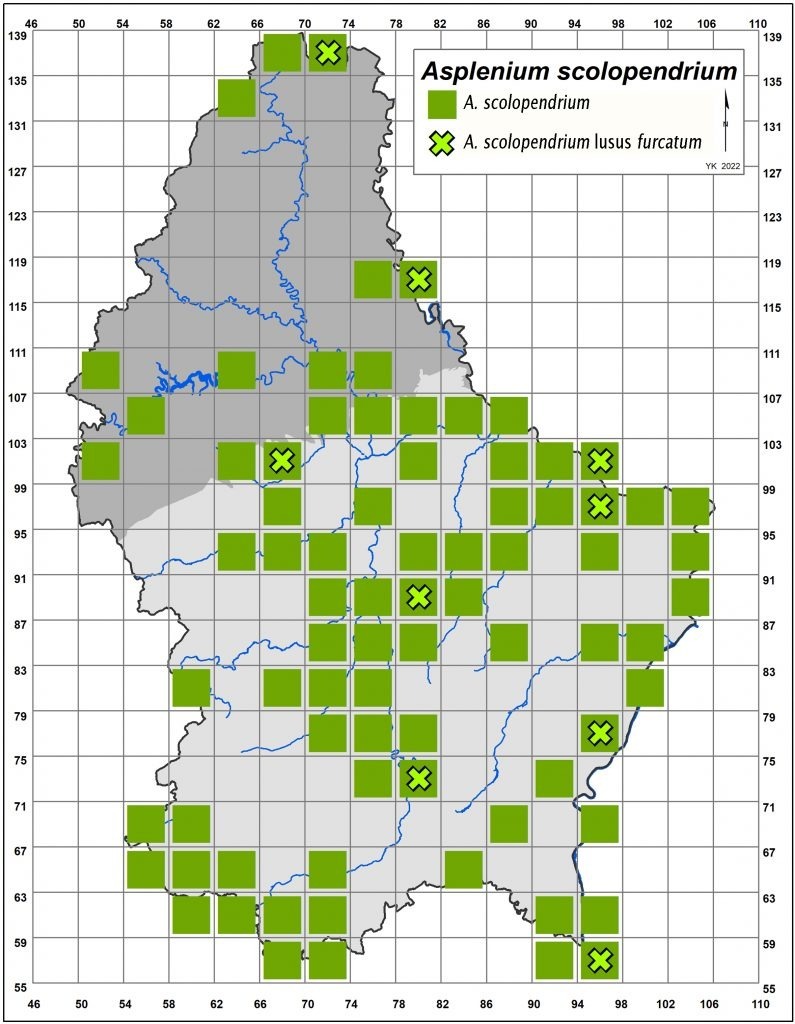
 Asplenium onopteris L.
Asplenium onopteris L.
 Acute-leaved spleenwort
Acute-leaved spleenwort
 Doradille des ânes
Doradille des ânes
 Spitziger Streifenfarn
Spitziger Streifenfarn
 Spatze Sträifefar
Spatze Sträifefar
Class: Pteridopsida
Family: Aspleniaceae
RE – regionally extinct
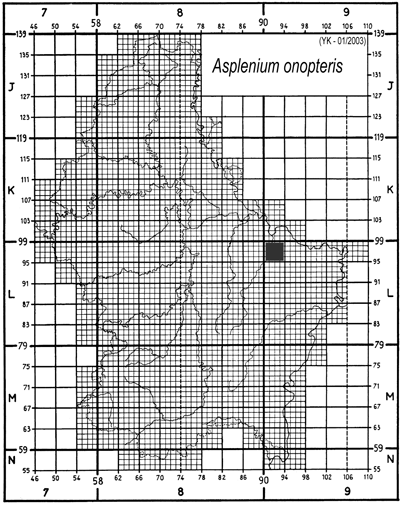
Asplenium cf. onopteris was discovered near Berdorf by A. Biermann in 1953 (Reichling 1954). There are no other sites known for Luxembourg. A recent revision however showed that it just was an acute-leaved form of Asplenium adiantum-nigrum !
Reichling, L., 1954. – Herborisations faites dans le Grand-Duché de Luxembourg en 1953. – Bull. Soc. Nat. luxemb. 58: 76-134.
 Asplenium trichomanes L. subsp. pachyrachis (Christ) Lovis & Reichstein
Asplenium trichomanes L. subsp. pachyrachis (Christ) Lovis & Reichstein
 Lobed Maidenhair Spleenwort
Lobed Maidenhair Spleenwort
 Capillaire à pétiole épais
Capillaire à pétiole épais
 Dickstieliger Brauner Streifenfarn
Dickstieliger Brauner Streifenfarn
 Gelappte Brongstillege Sträifefar
Gelappte Brongstillege Sträifefar
Class: Pteridopsida
Family: Aspleniaceae
LRlc – lower risk least concern

Investigation in order to localise Asplenium trichomanes L. subsp. pachyrachis (Christ) Lovis & Reichstein (Lobed Maidenhair Spleenwort) and to fix the distribution area for Luxembourg.
Asplenium trichomanes L. subsp. pachyrachis (Christ) Lovis & Reichstein
(Syn.: Asplenium csikii Kümmerle & Andras.) [Aspleniaceae, Pteridophyta]
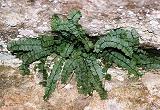
The Maidenhair Spleenwort (Asplenium trichomanes L.) is present throughout Luxembourg and quite frequent in natural rock habitats, as well as on walls of all types. Generally two subspecies of Asplenium trichomanes are distinguished: the rare subsp. trichomanes, growing on silicious rocks, and the common, rather calcicole subsp. quadrivalens. A third subspecies, Asplenium trichomanes subsp. pachyrachis (Lobed Maidenhair Spleenwort) – found in Europe at scattered locations – is known for Luxembourg since the early 1990-ties. Until 2001 only a few sites where known in Luxembourg, almost exclusively in the ‘Petite Suisse’ area.
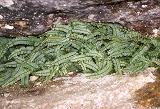
The plants of Asplenium trichomanes subsp. pachyrachis [Photo 1] are usually smaller and of paler coloration than those of subsp. quadrivalens. They always form a flat rosette of fronds which spread closely over the rock face, in a ‘starfish’ manner) [Photo 2].  The pinnae, usually subtriangular or even hastate are often overlapping, which gives each frond a congested overall appearance [Photo3]. Generally longer and more distinctly lobed than in the other subspecies, the pinnae are characterised by an often deeply crenately toothed margin with a conspicuous hyaline border.
The pinnae, usually subtriangular or even hastate are often overlapping, which gives each frond a congested overall appearance [Photo3]. Generally longer and more distinctly lobed than in the other subspecies, the pinnae are characterised by an often deeply crenately toothed margin with a conspicuous hyaline border.

Asplenium trichomanes subsp. pachyrachis can hybridise with subsp. quadrivalens, forming a vigorous plant with a more upright habit than subsp. pachyrachis and distinctly intermediate between the parents. It is known as Asplenium trichomanes L. nothossp. staufferi Lovis & Reichstein [Photo 4]. This hybrid is easily found in areas where the two parents are present and grows on natural rocks as well as on man-made walls.
A rapid investigation of natural sandstone outcrops, buildings, walls, … showed that Asplenium trichomanes subsp. pachyrachis is rather common in the sandstone area. Here it occurs on natural, often vertical rock surfaces, in crevices on steep rocks, as well as on sandstone walls. At present date [13/10/2020], many sites in over 80 square kilometers are known. Most of the sites occur in the ‘Petite Suisse’ area, but the Lobed Maidenhair Spleenwort is present in the whole sandstone area as far as Luxembourg-City.
The results of the investigations, with a description of the subspecies, the present distribution and status in Luxembourg can be found in:
Krippel, Y., 2003. – Aire de répartition et statut d’Asplenium trichomanes L. subsp. pachyrachis (Christ) Lovis & Reichstein(Aspleniaceae, Pteridophyta) au Luxembourg. – Bull. Soc. Nat. luxemb. 104: 3-12. [PDF 384 KB]
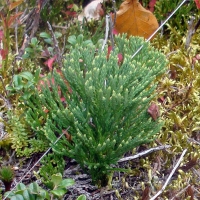 Diphasiastrum tristachyum (Pursh) Holub
Diphasiastrum tristachyum (Pursh) Holub
 Blue Ground-Cedar
Blue Ground-Cedar
 Lycopode petit cyprès
Lycopode petit cyprès
 Zypressen-Flachbärlapp
Zypressen-Flachbärlapp
 Zypressen-Hexemoos
Zypressen-Hexemoos
Class: Lycopodiopsida
Family: Lycopodiaceae
RE – regionally extinct
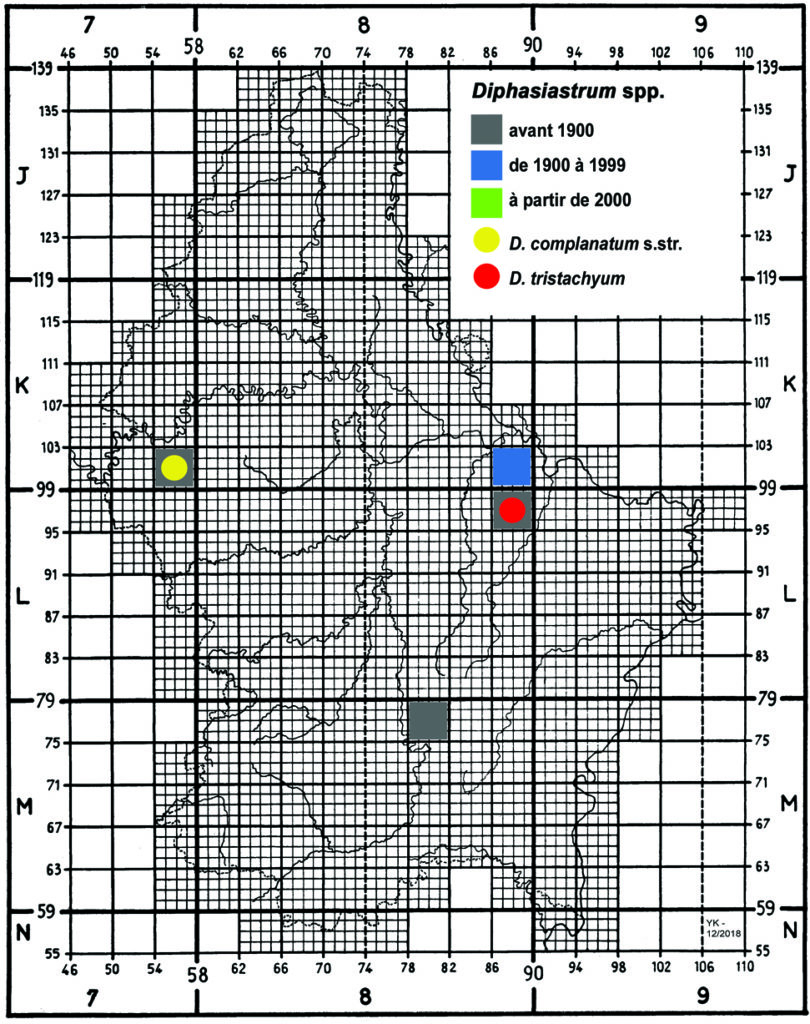
Diphasiastrum tristachyum was mentionned by Lawalrée (1951) for ‘Grunenwald’ between Rambrouch and Arsdorf (19th century), but the only documented record is Beaufort. Recent observations are lacking.
Lawalrée, A., 1951. – Les ptéridophytes du Grand-Duché de Luxembourg. – Bull. Soc. roy. Bot. Belg. 83: 225-240.
Krippel, Y. & J. A. Massard, 2019. – Les lycopodes (Lycopodiaceae) au Luxembourg – notes chorologiques et liste rouge. – Bull. Soc. Nat. luxemb. 121: 53-69.